Current events
Next talk tomorrow at 11:00 by Yeganeh Mirzanejad!
News 05.07.2025
New publication: Electric-Field-Tunable Spin−Orbit Gap in a Bilayer Graphene/WSe2 Quantum Dot
Site Content:
24.10.2014
New publication: Raman spectroscopy on mechanically exfoliated pristine graphene ribbons
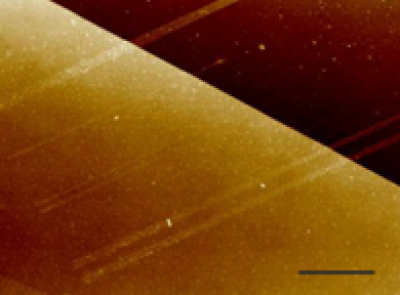
Physica Status Solidi B (online)
We present Raman spectroscopy measurements of non-etched graphene nanoribbons, with widths ranging from 15 to 160 nm, where the D-line intensity is strongly dependent on the polarization direction of the incident light. The extracted edge disorder correlation length is approximately one order of magnitude larger than on previously reported graphene ribbons fabricated by reactive ion etching techniques. This suggests a more regular crystallographic orientation of the non-etched graphene ribbons here presented. We further report on the ribbons width dependence of the line-width and frequency of the long-wavelength optical phonon mode (G-line) and the 2D-line in the studied graphene ribbons.

08.10.2014
New publication: Nanosecond Spin Lifetimes in Single- and Few-Layer Graphene–hBN Heterostructures at Room Temperature
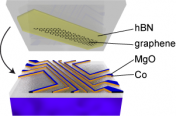
Nano Lett. 14, 6050 (2014)
We present a new fabrication method of graphene spin-valve devices that yields enhanced spin and charge transport properties by improving both the electrode-to-graphene and graphene-to-substrate interface. First, we prepare Co/MgO spin injection electrodes onto Si++/SiO2. Thereafter, we mechanically transfer a graphene–hBN heterostructure onto the prepatterned electrodes. We show that room temperature spin transport in single-, bi-, and trilayer graphene devices exhibit nanosecond spin lifetimes with spin diffusion lengths reaching

03.10.2014
New publication: Suppression of contact-induced spin dephasing in graphene/MgO/Co spin-valve devices by successive oxygen treatments
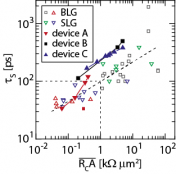
Phys. Rev. B 90, 165403 (2014)
By successive oxygen treatments of graphene nonlocal spin-valve devices we achieve a gradual increase of the contact-resistance–area products (RcA) of Co/MgO spin injection and detection electrodes and a transition from linear to nonlinear characteristics in the respective differential dV−dI curves. With this manipulation of the contacts, both spin lifetime and the amplitude of the spin signal can significantly be increased by a factor of seven in the same device. This demonstrates that contact-induced spin dephasing is the bottleneck for spin transport in graphene devices with small RcA values. With increasing RcA values, we furthermore observe the appearance of a second charge neutrality point (CNP) in gate-dependent resistance measurements. Simultaneously, we observe a decrease of the gate voltage separation between the two CNPs. The strong enhancement of the spin-transport properties as well as the changes in charge transport are explained by a gradual suppression of a Co-graphene interaction by improving the oxide barrier during oxygen treatment.

29.09.2014
New publication: Impact of thermal annealing on graphene devices encapsulated in hexagonal boron nitride
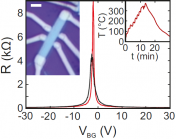
Physica Status Solidi B (online)
We present a thermal annealing study on single-layer and bilayer (BLG) graphene encapsulated in hexagonal boron nitride. The samples are characterized by electron transport and Raman spectroscopy measurements before and after each annealing step. While extracted material properties such as charge carrier mobility, overall doping, and strain are not influenced by the annealing, an initial annealing step lowers doping and strain variations and thus results in a more homogeneous sample. Additionally, the narrow 2D-sub-peak widths of the Raman spectrum of BLG, allow us to extract information about strain and doping values from the correlation of the 2D-peak and the G-peak positions.

16.09.2014
New publication: Limitations to carrier mobility and phase-coherent transport in bilayer graphene

Phys. Rev. Lett. 113, 126801 (2014)
We present transport measurements on high-mobility bilayer graphene fully encapsulated in hexagonal boron nitride. We show two terminal quantum Hall effect measurements which exhibit
full symmetry broken Landau levels at low magnetic fields. From weak localization measurements, we extract gate-tunable phase coherence times τφ as well as the inter- and intra-valley scattering times τi and τ∗. While τφ is in qualitative agreement with an electron-electron interaction mediated dephasing mechanism, electron spin-flip scattering processes are limiting τφ at low temperatures. The analysis of τi and τ∗ points to local strain fluctuation as the most probable mechanism for limiting the mobility in high-quality bilayer graphene.

14.09.2014
Cover Page: Zinc oxide –From dilute magnetic doping to spin transport (Phys. Status Solidi B 9/2014)
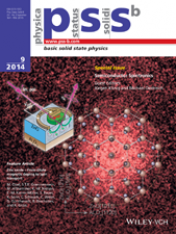
Phys. Status Solidi B (2014)
The front cover schematically shows three important aspects of the experiments. First, the lattice mismatch between ZnO and Al2O3 is reduced by rotating the ZnO lattice by 30°. Second, dilute magnetic doping with cobalt results in phase segregation and the formation of nanometer-sized metallic clusters, as indicated via the bright red contrast of the energy-filtered TEM image (background). Third, the sketched device allows for studying spin transport properties. A spin-polarized current from a magnetic Co electrode is injected into ZnO, and the spin polarization is determined optically via the polarization of reflected photons.
The source files for the front cover image were prepared by Matthias Althammer.

